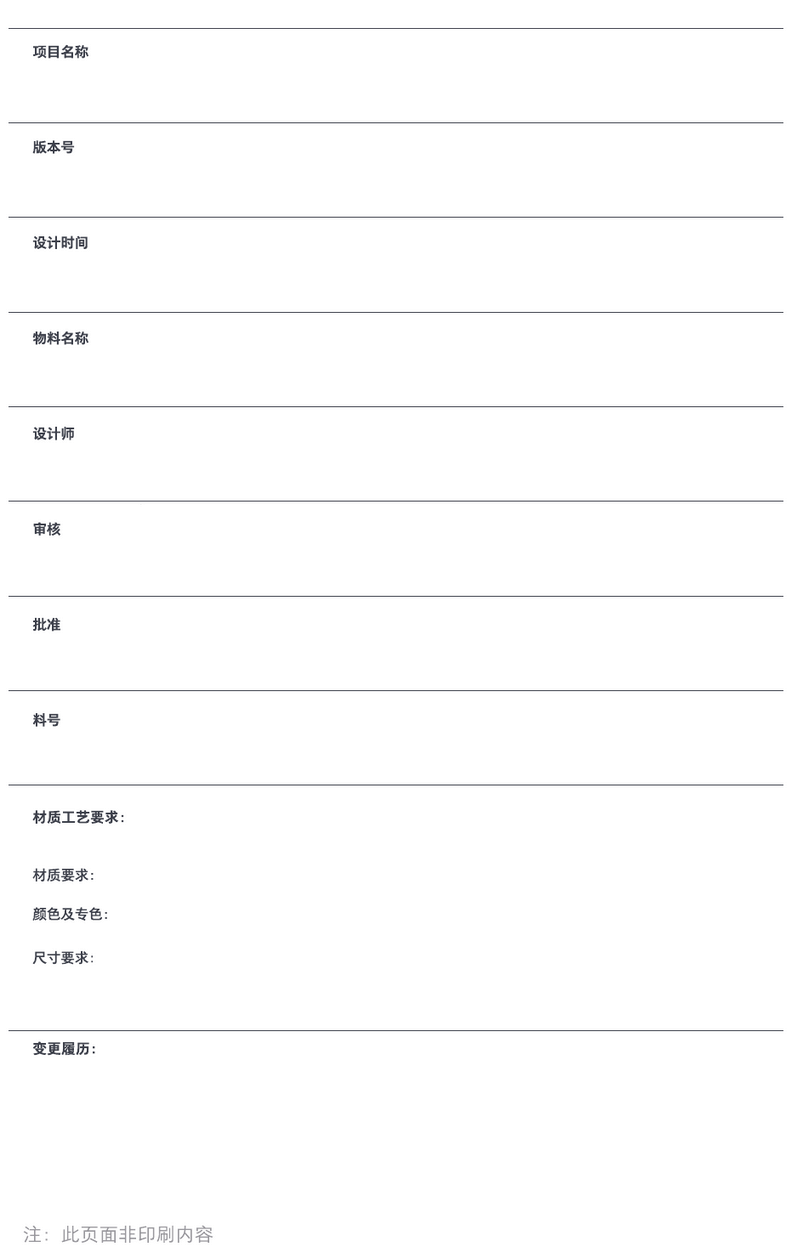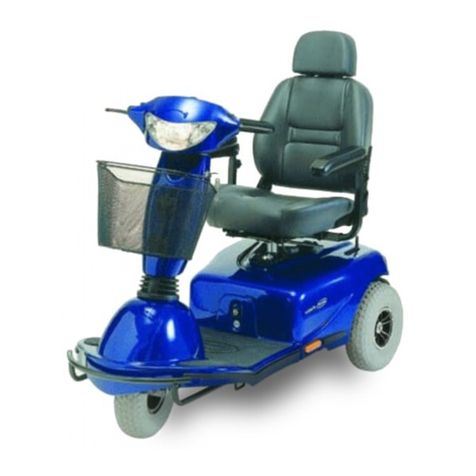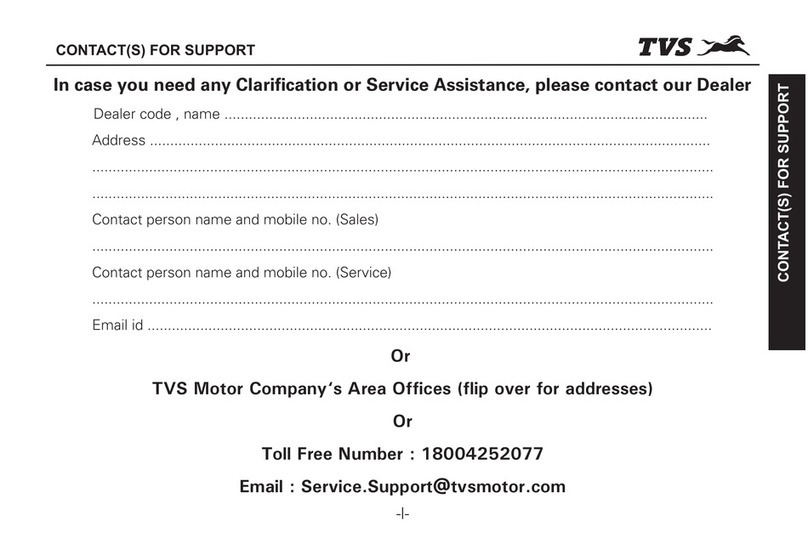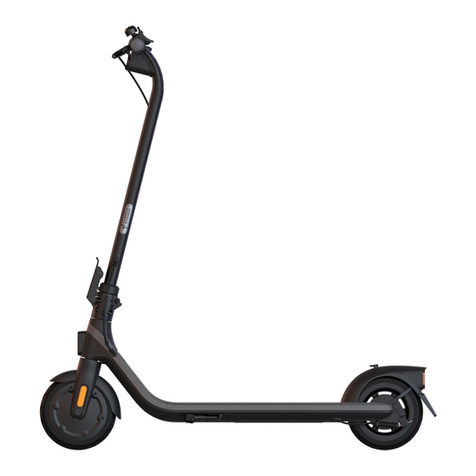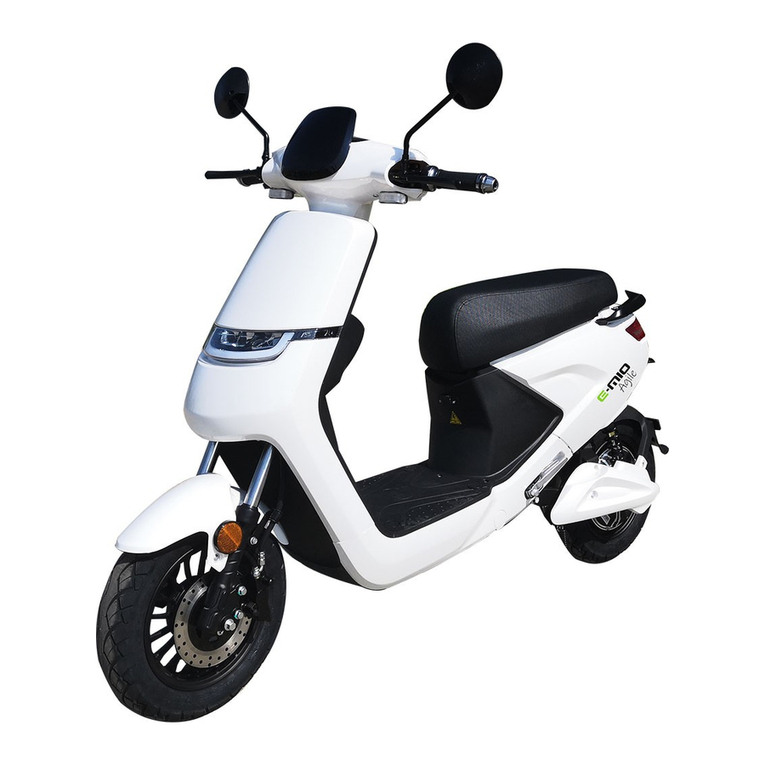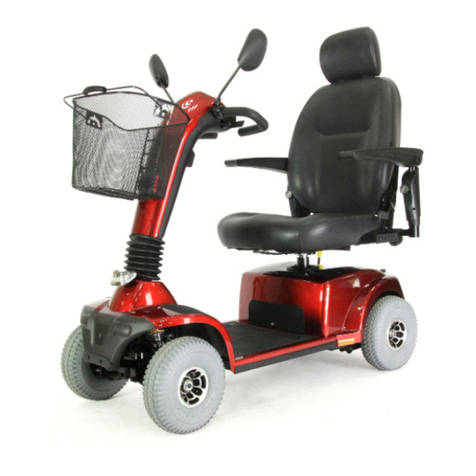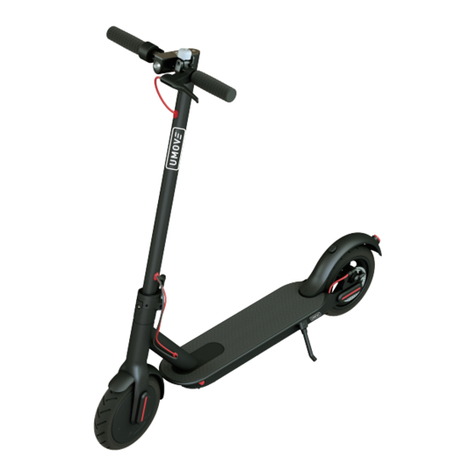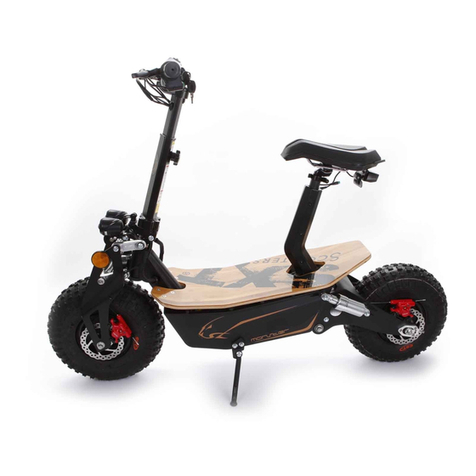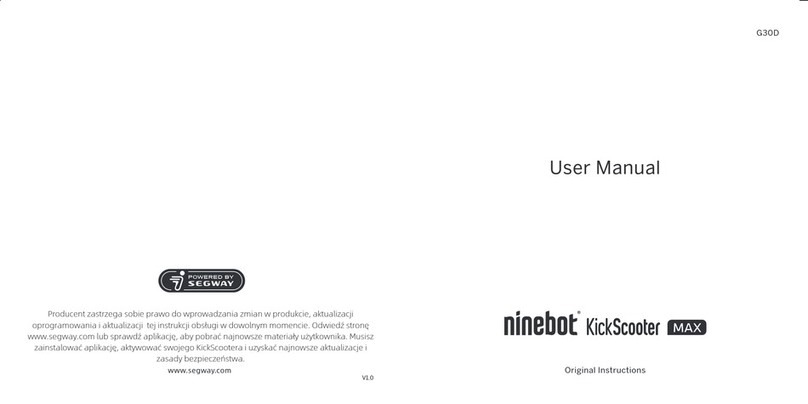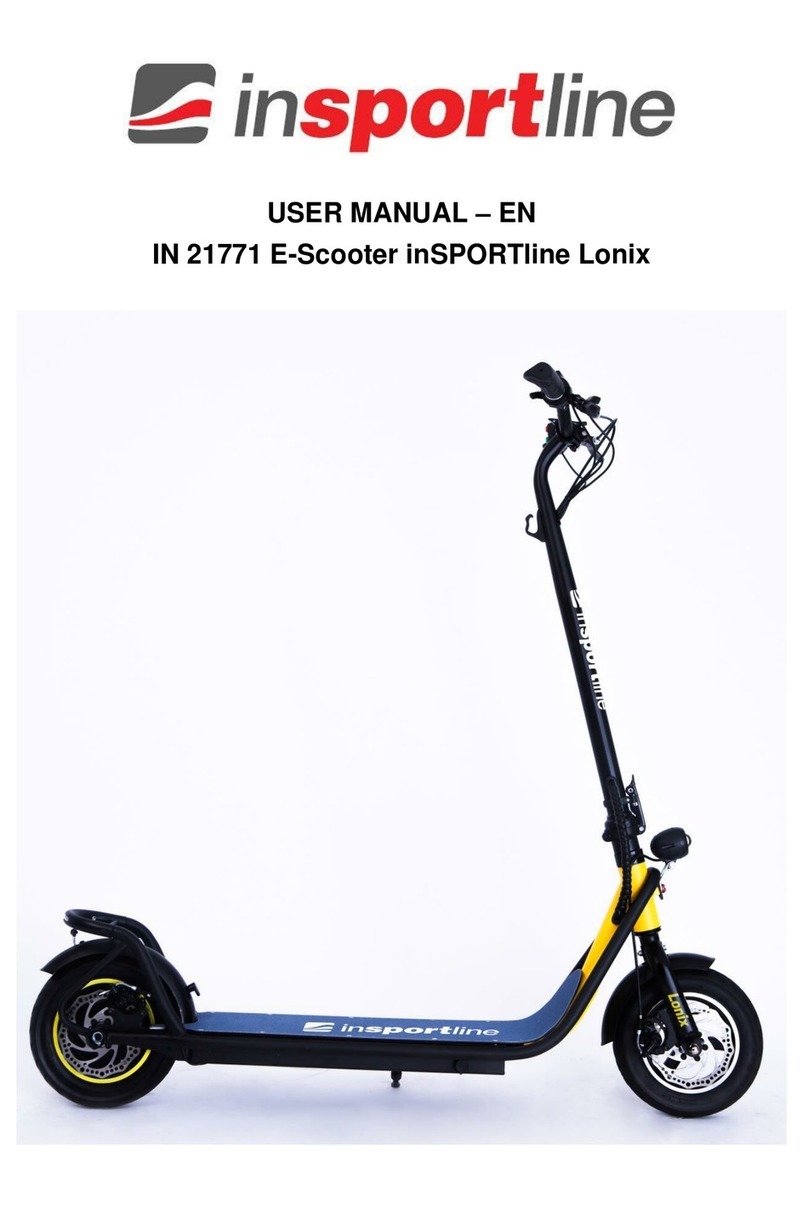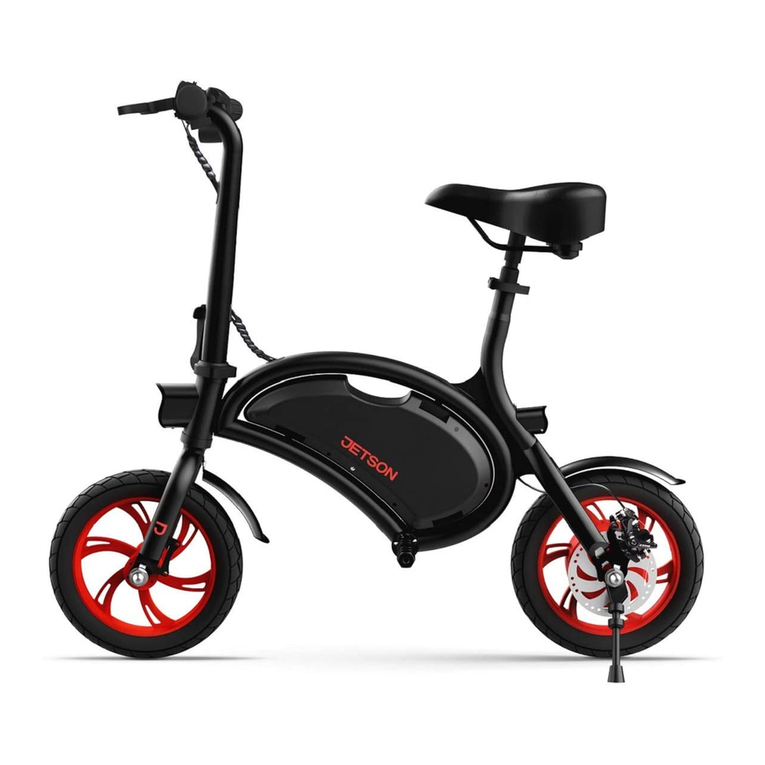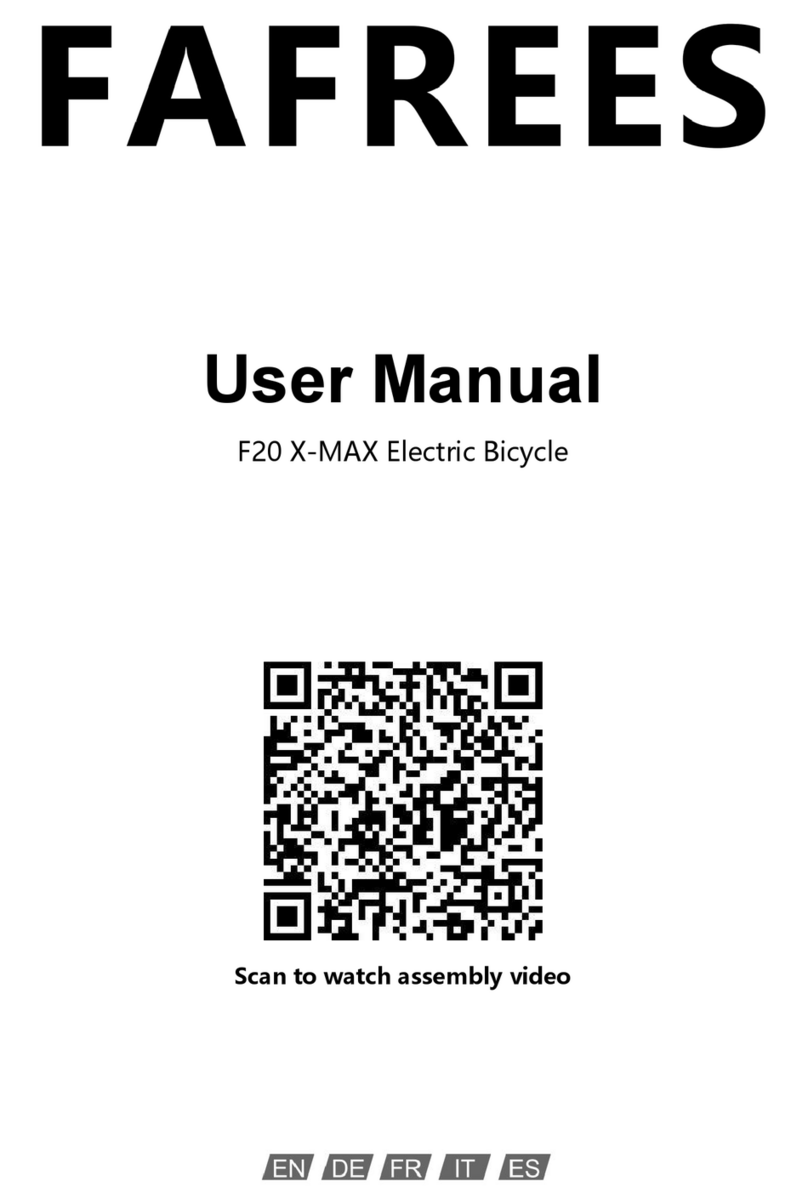Tomos FLEXER 45 User manual

FLEXER
USER’S MANUAL
NAvodiLo zA UpoRAbo
HANdbUCH

1
TOMOS
USER'S MANUAL
FLEXER 45

2
CONTENTS
Warnings 3
Riding Safety Tips 3
Technical Specification 4-5
Technical Description 6-9
Vehicle operation 10
Fuel 10
Engine Starting 10
Riding 12
Engine Running-In 12
Maintenance 13
Maintenance Operations 13
Lubricants 13
Gearbox Oil change 13
Fuse Replacement 14
Cleaning 14
Fuel System Cleaning 14
Exhaust System Cleaning 15
Vehicle Cleaning 16
Checks and Adjustments 16
Engine Oil Level Check 16
Bowden Adjustment 16
Transmission Chain Adjustment 17
Bolt and Nut Tightness 17
Maintenance Schedule 18
Battery Installation 19
Troubleshooting 20
Fuel System Troubles 20
Ignition System Troubles 20
Troubles Causing Reduced Engine Power 20
Gearbox Troubles 21
Electrical System Diagram 22

3
WARNINGS
Prior to operating the vehicle, carefully read this User's Manual in order
to get acquainted with its operational characteristics and safe and
proper operation.
1. Fuel is extremely flammable and explosive; therefore it requires
special handling precautions:
- Stop the engine prior to refilling the tank;
- Fill the tank outdoors; never approach the tank with a lit cigarette,
open flame or sparks; and
- Thoroughly wipe off any spilled fuel
2. The engine should not be run in an enclosed space or nearby
entrances to lower-level areas (cellars etc.). Engine exhaust gases are
toxic and denser than normal atmospheric air.
3. When starting or running the engine, never touch the ignition coil,
high voltage cable, ignition spark plug cap or other parts of the
electrical system.
4. The vehicle is equipped with a catalysts exhaust system causing
high temperatures. When the engine is running and for some time after
it has stopped do not touch its hot parts: the cylinder, the cylinder
head, exhaust silencer. Do not touch the brake components too.
5. When the engine is running beware of the engine’s rotating parts.
No modification of the vehicle, stripping-off any parts or installing non-
original spare parts is permitted. The vehicle owner is specifically
warned that any modification to the exhaust system can only result in
the vehicle’s deteriorated operation, without any positive effects on
engine performance and causes higher air pollution.
RIDING SAFETY TIPS
Riding a twowheeler is simple, yet it requires some skills and experience
which can only be accumulated progressively. Prior to each ride,
observe the following rules:
1. Check the proper functioning of all vehicle assemblies.
2. When riding, wear light-colored, preferably light-reflective clothes; ride
with your lights on; avoid riding in other drivers “blind spots” to prevent
danger of other drivers “overlooking” you.
3. Abide by all traffic regulations; above all, adjust your riding speed to
the road conditions and your skill level.
4. Do not hand the vehicle over to any inexperience riders.
5. Prior to changing lanes, always check that this can be done safely,
and signal your intention in time Be careful when riding trough road
crossings or passing other vehicles (including parked vehicles)..
6. Always ride with your helmet on, be properly dressed and wear boots.
7. Pay due the attention to what is going on in front of you and behind
you (rear mirror) and try to anticipate events
8. The braking affects the loading on each wheel: the front braking
increases; whereas braking with the rear brake only increases the
braking distance while also reducing vehicle stability; hence use the rear
brake with caution.

4
TECHNICAL SPECIFICATIONS
Model Flexer 45
Variants A24B – 45km/h
A24C – 30km/h
A24D – 25km/h
A24E – 20km/h
Engine Type single-cylinder, two-stroke
air-cooled
Displacement 49 cm3
Cylinder bore diameter 38 mm
Piston stroke 43 mm
VARIANT A24B:
Compression ratio 10 : 1
Engine power 1,7 kW at 4800 min-1
Torque 3,6 Nm at 3500 min-1
Maximum speed 45 km/h
Fuel consumption 1,8/100km
VARIANT A24C:
Compression ratio 6 : 1
Engine power 1,0 kW at 3500 min-1
Torque 3,1 Nm at 2500 min-1
Maximum speed 30 km/h
Fuel consumption 2,2/100km
VARIANT A24D:
Compression ratio 6 : 1
Engine power 1,0 kW at 3500 min-1
Torque 3,1 Nm at 2500 min-1
Maximum speed 25 km/h
Fuel consumption 2,5/100km
VARIANT A24E:
Compression ratio 6 : 1
Engine power 1,0 kW at 3500 min-1
Torque 3,1 Nm at 2500 min-1
Maximum speed 20 km/h
Fuel consumption 2,8/100km
Starter Electric (version) 12V 170W
Kick-starter or pedals

5
Fuel Tank capacity 3,5 l (incl.0,5 l reserve)
Engine oil reservoir 800 cm3
Suspension Front forks travel 70 mm
Rear shock absorber travel 35 mm
Wheels Front tire dimensions 2 ½ -16
Rear tire dimensions 2 ½ -16
Front tire inflation pressure 2,2 bar
Rear tire inflation pressure 2,2 bar
Electrical Magneto 12V 80W
system Spark advance preset
Spark plug-A24B Bosna F75, BOSCH-W7AC
Spark plug-A24C, A24D,
A24E Bosna F75, Champion-L86
Spark plug electrode clear. 0,8 mm
Headlight 12V 25W/25W + 12V/4W
Tail light 12V 5W
Stop light 12V 15W
Speedometer illumination 12V 2W
Direction indicators (version) 12V 10W
Direction indicator signal light 12V 1,5W
Oil level signal light 12V 1,5W
Low beam signal light 12V 1,5W
Main beam signal light 12V 1,5W
Battery (version) 12V 4Ah
Fuse (version) 8A
Dimensions Wheelbase 1.080 mm
And weights Total length of vehicle 1.640 mm
Vehicle mass (empty fuel tank) 59 +3 kg
Maximum permitted total weight 160 kg

6
TECHNICAL DESCRIPTION
1. Rear brake lever
2. Direction indicator switch (version)
3. Horn switch
4. Main beam/low beam switch
5. Speedometer
6. STOP switch
7. Electric start pushbutton (version)
8. Throttle lever
9. Front brake lever
10. Direction indicator signal light (version)
11. Oil level signal light (version)
12. Main beam signal light
13. Low beam signal light
14. Luggage carrier
15. Engine oil reservoir, cap (version)
16. Battery (version)
17. Contact key lock-left side (version)
18. Fuel filling vent
19. Fuse (version)
20. Air filter
21. Carburetor, choke
22. Fuel petcock
23. Oil pump
24. Fuel tank cap
25. Steering lock
26. Kick starter lever or pedals
27. Chain tension adjuster

7
1 2,3,4 5 6 7 8 9
Fig. 1
Fig. 2
10 11 12 13

8
Fig. 3
27 26
14 15 16 17 18 19 20 21 22 23 24 25

9
Fig. 5
Fig. 4
4
3
2
6
7

10
VEHICLE OPERATION
Fuel
EUROSUPER 95 and two-stroke engine oil.
Your vehicle is equipped with an oil pump, which adds a specified
amount of oil to the petrol (approx. 2%). Pour two-stroke oil into the
separate oil reservoir (15, Fig. 3) - approximately 0,8 liter).
Use only high quality fully synthetic two-stroke oil.
CAUTION!
Prior to starting the engine for the first time, fill the fuel tank (24, Fig. 3)
with approx. 1 liter mixture of two-stroke oil and gasoline in the ratio of
1:50 (2%), then start the engine and let it run for at least 8 minutes in
order to allow the oil pump to fill the suction pipe.
Before this take off the oil pump cover (23, Fig. 3) and unscrew the bolt
on oil pump (A, Fig. 4) and wait till oil comes from reservoir. Tighten
the bolt.
Engine starting
Open the fuel cock (Fig. 6). Note: A – fuel supply shot, B – fuel supply
on, C - reserve.
If the engine is cold, pressthe cold start lever (B, Fig. 7).
Kick start version:
With the throttle fully closed, press the rear brake lever and press the
kick-starter lever (26, Fig. 3) – without opening the throttle.
If starting the engine when it is still warm, the throttle must be fully
opened.
Pedal version:
With the throttle fully closed, press the rear brake lever and press the
pedals (26, Fig. 3) backwards – without opening the throttle.
If starting the engine when it is still warm, the throttle must be fully
opened.
Electric starter version:
Enter the key in the ignition switch (17, Fig. 3) and turn it to the ON
position. Switch on the stop switch (6, Fig. 5). With the throttle fully
closed, press the rear brake lever and press electric start pushbutton
(7, Fig. 5).

11
Caution: If the engine on the electric start version fails to start,
release the starter pushbutton. This prevents the battery from
draining. Do not keep the engine start pushbutton depressed longer
than 5 seconds. Should the electric starter fail to start the engine start
the engine by using the kick-starter lever or pedals (depending on
version).
When using the choke, allow the engine to run for 10 to 20 seconds
without opening the throttle. The choke start lever disengages
automatically when the throttle is opened.
In the case the engine is hot do not use the choke lever.
Fig.6

12
Riding
The speed is controlled by the throttle lever (8, Fig. 1).
Engaging the first or second gear is done by opening or
closing the throttle. Avoid switching too frequently between
first and second gears. In such situation you should instead
reduce the throttle opening and keep the vehicle in first gear.
When descending a slope, shortly open the throttle from time
to time in order to improve lubrication and headlight
operation. The vehicle is shut down by closing the throttle
lever and switching the STOP button to the position off (6,
Fig. 5). Then close the fuel cock (position A, Fig. 6)!
If the vehicle is to stay out of operation for a longer period
(e.g. during winter), draining of the fuel from the carburetor
cup in the following way is recommended: close the fuel cock
and, by opening the throttle lever, let the engine run out
automatically.
Engine Running-in
Do not run the engine at full throttle during the initial 100 km.
Later increase the engine loading progressively.
Fig. 7

13
MAINTENANCE
Maintenance Operations
The vehicle is easy to maintain, yet maintenance is imperative for
perfect performance. Particularly important operations include regular
lubrication of individual assemblies, gearbox oil changes, cleaning of
parts affecting engine operation (spark plug, exhaust system, fuel
system) and checking of safety-related riding components (tire
pressure, operation of lights and brakes, tightness of bolts and nuts).
The maintenance table defines maintenance works in certain intervals
in km and months - consider whichever comes first - for the period
up to 20.000 km or 24 months.
Lubricants
For the gearbox apply the automatic gearbox oil: ATF A or ATF F. For
lubrication of other vehicle components (see the maintenance
schedule), application of SAE 30 grade engine oil and LIS 2 grease is
recommended.
Gearbox Oil Change
Oil should be changed when the engine is still warm. Remove the right
side shield; release three threaded plugs (1, 2, 3, Fig. 8) on the right
side of the engine casing, and let the oil drain completely. Retighten oil
draining plug (3, Fig. 8) and pour approx. 300 cm3of oil through the
refilling opening (1, Fig. 8), so that oil level reaches the control
opening (2, Fig. 8). Then, retighten the oil refilling and control opening
plugs.
Fig. 8

14
Fig. 9
Fuse replacement (version)
The fuse is located near to the battery. If the fuse is blown, turn the
ignition switch (17, Fig. 3) to the position OFF. Replace the fuse with a
new one of the correct specification. Return the ignition switch to the
ON position and check operation. If the new fuse blows as well, have
the electrical circuit examined by an authorized service agent.
Caution: Do not install a fuse with higher capacity than specified. An
incorrect fuse could seriously damage the electrical system or even
cause a fire.
CLEANING
Fuel System Cleaning (Fig. 9)
As regards the fuel system, periodic cleaning of the main jet, air filter
and fuel petcock filter is required. Do not use metal objects to clean the
main jet; clean it with an air jet.
Filter – sponge should be washed thoroughly in gasoline. After
washing, squeeze gasoline from the sponge (do not brush it) and dry
the sponge in a dry air jet.

15
Exhaust system cleaning (Fig. 10)
The build up of soot in the exhaust system obstructs the free passage
of exhaust gas and thereby reduces engine power.
Periodically, clean the cylinder exhaust duct, exhaust pipe inlet
opening, piston crown and cylinder compression chamber (Fig.11).
Caution: exhaust system is equipped with catalysts, so do not enter
into the exhaust pipe with any tools, wires, do not pour in any fluid, etc.
Any such intervention can cause damage of the catalysts.
We strongly suggest making exhaust system cleaning by an authorized
service agent.
Fig. 10
Fig. 11

16
Vehicle cleaning
Vehicle exterior cleaning is also part of regular maintenance. After
washing, wipe the vehicle dry. Protect painted surfaces with paint
protection agents. After cleaning, check the operation of the engine,
the lights and brakes.
CHECK AND ADJUSTMENTS
Engine Oil Level Check
Check regularly the oil level in the oil tank. Top up as required. Should
the warning light fail to extinguish after starting the engine, this means
the oil level is low and immediate topping up is required.
Caution:
Electric starter version: the warning light must come on when the
ignition key is turned to ON. If does not, the fault should be remedied.
Kick-starter and pedals version: the warning light lights few seconds
after starting the engine. If does not, the fault should be remedied.
Bowden Adjustment
Bowden brakes are adjusted by means of the bolts on the wheels
hubs. The Bowden is properly set when the brake lever free travel is
10-15 mm and the sleeve – lever gap is approx. 3 mm (Fig. 12). After
adjusting, make sure the jam nut is retightened.
sl. 15
Fig. 12
B

17
Transmission Chain Adjustment
The chain tension should be adjusted so that the chain yields 10 mm up
or down under pressure (Fig. 13). Adjust the chain tension by spinning
the chain tension adjuster (27, Fig. 3) on the rear wheel axle. After the
adjustment, retighten the nuts on the both side of axle that were party
released for the adjusting.
Bolt and Nut Tightness
Periodically check and retighten as necessary the bolts and nuts of the
main vehicle components (wheels, handlebar, shock absorber, rear
fork axis, engine to frame bolts, gearbox oil drain plug).
Fig. 13

18
MAINTENANCE SCHEDULE
Interval (km)
1.000
3.000
10.000,
15.000, 20.000
Interval (months)
2
6
12, 18, 24
Oil lubrication
1. Gearbox oil change
•
•
•
2. Bowdens (internal cables)
As necessary
3. Chain
•
•
•
Greasing
4. Rear fork bearing bushes
As necessary
5. Steering bearings
•
Cleaning
6. Spark plug As necessary
7. Air filter (oiling)
•
•
8. Cylinder head, piston head, exhaust duct
•
•
9. Cylinder and exhaust pipe
•
•
Interval (km)
1.000
3.000
10.000,
15.000, 20.000
Interval (months)
2
6
12, 18, 24
Checks and adjustments
10. Gearbox oil level
•
•
•
11. Horn and lights
•
•
•
12. Sparkplugelectrodeclearance
•
•
•
13. Brake operation check and adj.
•
•
•
14. Steering bearing clearance
•
•
•
15. Wheel bearing clearance
•
•
•
16. Wheel track
•
•
17. Tire pressure
•
•
•
(front and rear 2,2 bar)
18. Chain tension
•
•
•
19. Idle run and throttle
•
•
•
20. Bolt and nut tightness
•
•
•

19
BATTERY INSTALLATION (VERSION)
Battery is placed under the luggage carrier. (A, Fig. 14).
Release the two bolts (B, Fig.14) and from the bottom side of the
luggage carrier pull out the plastic box for battery. Place the battery in
the box with the connection shoes upwards. Applying the bolts
supplied with the battery, connect the blue color electric cable to the
blue color battery connection shoe (-) and the red color electric cable to
the red color battery connection shoe (+).
Caution: When placing the battery box under the mudguard, take care
that cables are placed into the groove on the left side of the battery
box. (C, Fig.15).
Fig.14
Fig.15
A B
C
This manual suits for next models
1
Table of contents
